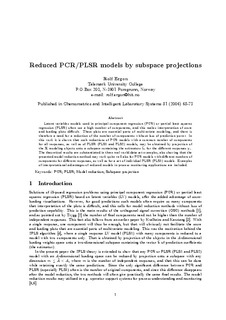| dc.contributor.author | Ergon, Rolf | |
| dc.date.accessioned | 2007-02-08T08:55:20Z | |
| dc.date.accessioned | 2017-04-19T12:50:11Z | |
| dc.date.available | 2007-02-08T08:55:20Z | |
| dc.date.available | 2017-04-19T12:50:11Z | |
| dc.date.issued | 2006 | |
| dc.identifier.citation | Chemometrics and intelligent laboratory systems 81 (2006), No. 1, p. 68-73 | |
| dc.identifier.issn | 0169-7439 | |
| dc.identifier.uri | http://hdl.handle.net/11250/2438470 | |
| dc.description.abstract | Latent variables models used in principal component regression (PCR) or partial least squares regression (PLSR) often use a high number of components, and this makes interpretation of score and loading plots difficult. These plots are essential parts of multivariate modeling, and there is therefore a need for a reduction of the number of components without loss of prediction power. In this work, it is shown that such reductions of PCR models with a common number of components for all responses, as well as of PLSR (PLS1 and PLS2) models, may be obtained by projection of the X modeling objects onto a subspace containing the estimators b Ë i for the different responses yi . The theoretical results are substantiated in three real world data set examples, also showing that the presented model reduction method may work quite well also for PCR models with different numbers of components for different responses, as well as for a set of individual PLSR (PLS1) models. Examples of interpretational advantages of reduced models in process monitoring applications are included. | |
| dc.format.extent | 420862 bytes | |
| dc.format.mimetype | application/pdf | |
| dc.language.iso | eng | |
| dc.publisher | Elsevier | |
| dc.subject | PCR | |
| dc.subject | PLSR | |
| dc.subject | Model reduction | |
| dc.subject | Subspace projection | |
| dc.title | Reduced PCR/PLSR models by subspace projections | |
| dc.type | Journal article | |
| dc.type | Peer reviewed | |
| dc.subject.nsi | 563 | |
| dc.identifier.doi | http://dx.doi.org/10.1016/j.chemolab.2005.09.008 | |
